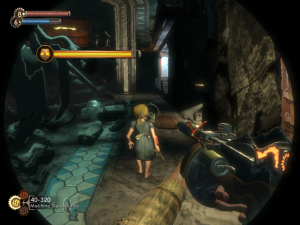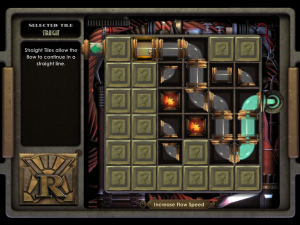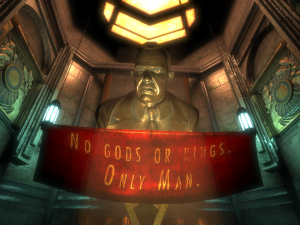Bioshock: Would you kindly finish the game?
I’ve cited superhero comics as an influence on Bioshock already, but the single most superhero-like moment in the game comes when you start catching up to Atlas, and he blocks your progress by hefting and throwing massive pieces of architecture at you, and striking an Action Comics #1 pose to do it. I suppose he has plasmids that I don’t — I can’t even lift so much as a brick except by telekinesis. 1Telekinesis in this game, by the way, is an obvious imitation of Half-Life 2‘s gravity gun. Not that I necessarily want whatever he’s been taking. By the time of your final boss fight, all the splicing has turned him into something monstrous, resembling a living version of that Atlas statue.
Mind you, the player character has his own brush with monstrosity. The penultimate level comes up with an excuse to get the player character to disguise himself as a Big Daddy — or possibly actually become one. This is a multi-part quest: you get the suit here, the boots there, the voice-box that produces those whalesong-like cries another place. Atlas sends you taunting messages warning about the consequences of what you’re doing, but it isn’t until you’re well into the process that you start finding reasons to believe that it’s not reversible. An audio log describes how the suit doesn’t work unless it’s bonded to the internal organs, replacing the skin. The voice-box is installed with a vicious-looking device that could plausibly be replacing your larynx. You naturally start to wonder just what you’re doing to yourself, what you’re giving up. It all leads into an escort mission, protecting a Little Sister (or, more accurately, a little girl who used to be a Little Sister) as she makes her rounds, and it’s easy to think “Is this how it’s going to be from now on for the rest of my life?”
 But then, the game isn’t consistent about its presentation of your new status. Your first-person view has the circular window of a Big Daddy’s helmet superimposed on it (with some nice distortion effects at the edges), but your hands, when visible, show no such alteration. And when you go into the final boss fight, any sign or memory of the terrible possibilities just goes away. I can understand why they’d want a happy ending here (even though they miss out on a chance for a really memorably dark one), but I would have liked at least a word acknowledging the implications of the previous section.
But then, the game isn’t consistent about its presentation of your new status. Your first-person view has the circular window of a Big Daddy’s helmet superimposed on it (with some nice distortion effects at the edges), but your hands, when visible, show no such alteration. And when you go into the final boss fight, any sign or memory of the terrible possibilities just goes away. I can understand why they’d want a happy ending here (even though they miss out on a chance for a really memorably dark one), but I would have liked at least a word acknowledging the implications of the previous section.
Looking at a walkthrough afterward to find out what I’d missed, I saw one that concluded with the words “Congratulations, Rapture is saved!” I can only assume that this was put in as a matter of habit, part of the general walkthrough formula, because it’s flabbergasting in its wrongness. Your struggle towards the end is to save the outside world from a super-powered Frank Fontaine, or, if you’re playing the Sith path, to seize his Adam for yourself. Rapture is beyond saving. Its founder doesn’t even believe in salvation — not just in the religious sense, but in that he doesn’t believe in altruistic acts. And when you come down to it, the story of this game is primarily the story of a collapse. That’s unusual in games, even though ruins are a common setting — usually they’re just a setting, and the focus is on the player’s reason for being there. In Bioshock, the player’s real reason for being there is intimately linked with the ongoing collapse.
And the cause of the collapse? Given the Objectivist window-dressing, the obvious way to read the game is as a warning against the consequences of that philosophy. But, as I noted before, that point is blunted by Fontaine’s involvement. Or is it? The rise of Atlas and his revolution was made possible by the large numbers of dissatisfied poor (who weren’t allowed to leave Rapture lest they betray the secret of its existence to the outside world), and is therefore a consequence of Ryan’s no-social-safety-net policy. Something was going to break; Fontaine simply rode the wave, and satisfied videogame conventions by providing the player with something to kill.
It’s been suggested that we can’t really blame Objectivism for what happened, because Ryan had abandoned so many of Objectivism’s core tenets: initiating the use of force, robbing people of their free will through genetic manipulation. But that’s kind of the point. Ryan’s project was idealistic, and Ryan was unable to sustain that idealism. Even the “No gods or kings” bit is implicitly betrayed from the beginning by the way city features are named: Apollo Square, Port Poseidon, etc. Back at the point when you confront him, it’s notable how defeated he already is, despite his earlier appearance of nigh-omnipotent control: locked in his bunker-like office, alone, unable to affect what’s going on outside, finally understanding your mission but unable to do anything about it. He orders you to kill him, using your command words. Some have said that this represents a kind of victory on his part, proving to you that you’re no more than a slave. But he could have proved that with any command. By ordering his own death, he desperately takes the only sort of control he can over his fate, and the fate of Rapture.
I suppose this is why we didn’t have a boss fight against Ryan. He’s the personification of a certain set of ideals, and of how they can go wrong. To turn him into a powerful figure who has to be fought, and to make it possible to lose that fight, would be to suggest that his ideals are still powerful, and undermine the theme of inevitable collapse. Instead, the end boss is Fontaine, personification of things not going as planned.
| ↑1 | Telekinesis in this game, by the way, is an obvious imitation of Half-Life 2‘s gravity gun. |
|---|
 Comments(2)
Comments(2)

